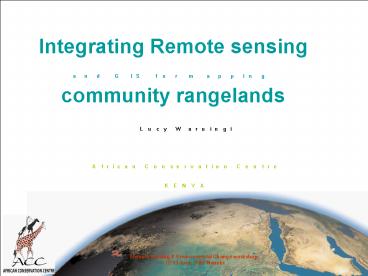Remote sensing PowerPoint PPT Presentation
1 / 24
Title: Remote sensing
1
Integrating Remote sensing and GIS for mapping
community rangelands
- Lucy Waruingi
- African Conservation Centre
- KENYA
2
Objectives of Study
- Objective 1 Integrating remote sensing and GIS
to analyse the land cover/land-use on community
rangelands - Objective 2 Determining areas of biological
importance with regard to wildlife in community
rangelands - Objective 3 Selecting areas suitable/viable for
monitoring by community game scouts
3
Community rangelands
- Dry lands make up 40 of the earths land mass
and support nearly 2 billion people (White et
al., 2002). - Well endowed with flora and fauna and scenic
landscapes with major tourism potential - In Kenya they are set up as group ranches,
members share the natural resources - Maasai have long history of co-existence
- Occupation mainly pastoralism or mixed farming
4
Threats to rangelands
- Population growth
- Sedenarisation
- Land subdivision
- Habitat fragmentation
- Conflicting land uses
- Human-wildlife conflict
- Competition for resources
- Drought
- Climate change
5
Mapping of rangelands
- Collection and compilation of biological data and
mapping of resources has been the preserve of
scientists - In Kenya remote sensing research has been
generally focused on land cover changes and
habitat distribution in and around national parks
(Serneels et al. 2001 Oindo et al. 2003). - Involvement of the local people in collecting and
mapping information of their own rangelands is
critical for sustainable use of their resources - Use of landsat imagery, various GIS techniques,
with other biological data provides a framework
for mapping of community rangelands
6
Why use maps?
- Maps provide a common language for communities to
participate in managing of their lands
7
Landsat ETM 2000 2001False color
8
Classified Landsat ETMland cover/use
9
GIS analysis of Wildlife Resources
- Wildlife census on 55 km grid (30 years of data)
analysed for wet and dry seasons - Use remote sensing to get a snapshot of landscape
(landcover/landuse) - Use GIS to summarise historical ecological and
biological data - Train scouts on basic ecology, human-wildlife
conflict, tourism, map reading, use of GPS and
environmental management
10
Landcover Wildlife distribution (WET)
11
Landcover Wildlife distribution (DRY)
12
Scientists - Scouts
- Community scouts
- Unschooled unskilled
- No equipment / tools
- Foot/bicycle patrols
- Knowledge of their landscape
- Have co-existed with for decades with nature
- Conventional mapping of resources
- field biologists to collect data regularly for
years - Special equipment
- Set of tools and methods
13
Engaging the local people
- Modified monitoring sheets translated
- to local languages
- Use remote sensing to get a snapshot of
landscape (landcover/landuse) - Use GIS to summarise historical ecological and
biological data - Train scouts on basic ecology, human-wildlife
conflict, tourism, map reading, use of GPS and
environmental management
14
Simplified monitoring sheets WEEKLY
2 Early ShootsEmpilili Short GreenOlari
Ngejuk Long GreenOlari Olperesso Long
BrownAmeyu Short Brown Ameyu
15
Community Scouts - Transects
Viewshed analysis
16
Community Scouts Network
- On predetermined walking transects
- Selected habitats from classified image
- Use of DEM and visibility to determine suitable
sampling areas for each habitat
17
Crop damage, Human death, injury, property damage
18
(No Transcript)
19
Joint management plan
Tourism (facilities and activities) Livestock
(grazing patterns) Security (communication,
patrols) Agriculture Infrastructure Marketing Cons
ervation area Settlements
Map B
Map A
20
Achievements
- Monitoring over the last 2 years has enhanced
understanding of the area and resource use and
conflict - Information of wildlife numbers, habitat
conditions, impact of drought and poached species
available - Joint participatory landuse zoning brings
ownership to the agreed on landuse plans - Joint security operations and anti-poaching
patrols - Environmental protection charcoal burning
21
More achievements.
- Engaging in eco-tourism enterprises
- Setting aside of conservation areas
22
Challenges
- Current satellite imagery quite costly, this
study used data of 2000, 2001 - Technical expertise is required in interpretation
of images - Establishing consistent classes for landcover
interpretation
23
Conclusion
- GIS and Remote sensing can be used as tools to
enhance the monitoring mapping community
rangelands - Maps provide a framework for integration of local
spatial knowledge and provides a common language - Local communities can learn adapted data
collection methodologies for management and use
of their environment and natural resources.
24
Asante Sana!
- www.conservationafrica.org
- lucy.waruingi_at_acc.or.ke

